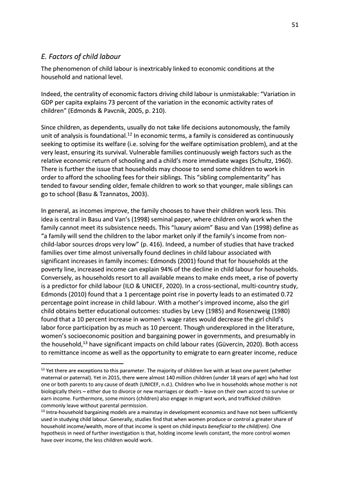51
E. Factors of child labour The phenomenon of child labour is inextricably linked to economic conditions at the household and national level. Indeed, the centrality of economic factors driving child labour is unmistakable: “Variation in GDP per capita explains 73 percent of the variation in the economic activity rates of children” (Edmonds & Pavcnik, 2005, p. 210). Since children, as dependents, usually do not take life decisions autonomously, the family unit of analysis is foundational.12 In economic terms, a family is considered as continuously seeking to optimise its welfare (i.e. solving for the welfare optimisation problem), and at the very least, ensuring its survival. Vulnerable families continuously weigh factors such as the relative economic return of schooling and a child’s more immediate wages (Schultz, 1960). There is further the issue that households may choose to send some children to work in order to afford the schooling fees for their siblings. This “sibling complementarity” has tended to favour sending older, female children to work so that younger, male siblings can go to school (Basu & Tzannatos, 2003). In general, as incomes improve, the family chooses to have their children work less. This idea is central in Basu and Van’s (1998) seminal paper, where children only work when the family cannot meet its subsistence needs. This “luxury axiom” Basu and Van (1998) define as “a family will send the children to the labor market only if the family’s income from nonchild-labor sources drops very low” (p. 416). Indeed, a number of studies that have tracked families over time almost universally found declines in child labour associated with significant increases in family incomes: Edmonds (2001) found that for households at the poverty line, increased income can explain 94% of the decline in child labour for households. Conversely, as households resort to all available means to make ends meet, a rise of poverty is a predictor for child labour (ILO & UNICEF, 2020). In a cross-sectional, multi-country study, Edmonds (2010) found that a 1 percentage point rise in poverty leads to an estimated 0.72 percentage point increase in child labour. With a mother’s improved income, also the girl child obtains better educational outcomes: studies by Levy (1985) and Rosenzweig (1980) found that a 10 percent increase in women’s wage rates would decrease the girl child’s labor force participation by as much as 10 percent. Though underexplored in the literature, women’s socioeconomic position and bargaining power in governments, and presumably in the household,13 have significant impacts on child labour rates (Güvercin, 2020). Both access to remittance income as well as the opportunity to emigrate to earn greater income, reduce 12
Yet there are exceptions to this parameter. The majority of children live with at least one parent (whether maternal or paternal). Yet in 2015, there were almost 140 million children (under 18 years of age) who had lost one or both parents to any cause of death (UNICEF, n.d.). Children who live in households whose mother is not biologically theirs – either due to divorce or new marriages or death – leave on their own accord to survive or earn income. Furthermore, some minors (children) also engage in migrant work, and trafficked children commonly leave without parental permission. 13 Intra-household bargaining models are a mainstay in development economics and have not been sufficiently used in studying child labour. Generally, studies find that when women produce or control a greater share of household income/wealth, more of that income is spent on child inputs beneficial to the child(ren). One hypothesis in need of further investigation is that, holding income levels constant, the more control women have over income, the less children would work.













